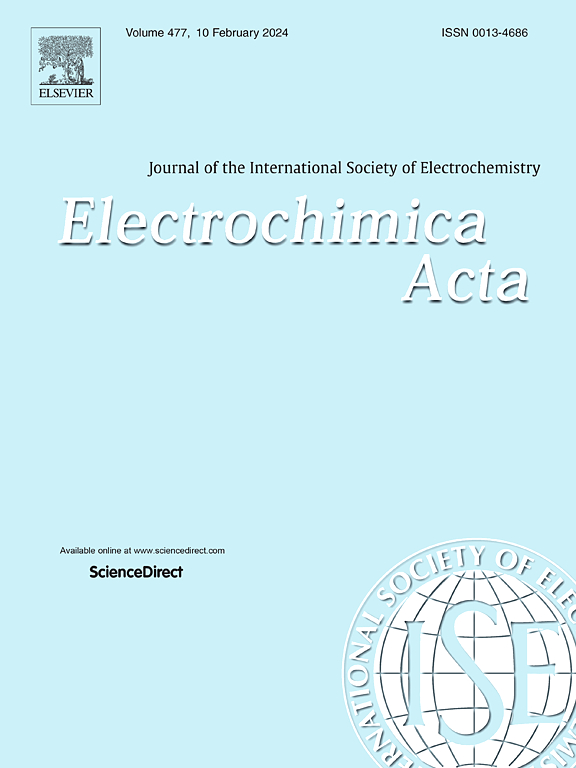电化学羧化:使用掺硼金刚石电极绿色合成阿曲酸
IF 5.5
3区 材料科学
Q1 ELECTROCHEMISTRY
引用次数: 0
摘要
电化学二氧化碳固定法对化学工业的可持续发展至关重要,但选择性合成多碳产品仍具有挑战性。有机电合成技术能够精确控制反应条件,并促进新的反应模式,因此前景广阔。电化学羧化就是这样一种技术,它将二氧化碳与有机分子耦合,生成羧酸。具体来说,对苯乙酮进行电羧化反应可产生阿曲酸,这是一种非甾体抗炎药物的重要前体,为传统生产方法提供了一种更环保的替代方法。本研究的重点是利用微波等离子体辅助化学气相沉积(MP-CVD)方法合成掺硼金刚石(BDD)薄膜并对其进行表征,然后将合成的 BDD 电极用于苯乙酮的电解羧化。在对 BDD 薄膜进行表征时,采用了多种分析技术,包括 X 射线衍射 (XRD)、拉曼光谱和激光显微镜等。在电解羧化苯乙酮的过程中,使用了不同时间合成的 BDD 薄膜,其中使用 6 小时合成的 BDD 薄膜合成的阿曲酸产量最高(25%)。此外,还研究了 BDD 表面改性(即氧和氢终止 BDD)对阿特拉酸合成的影响。此外,在阿特乳酸的合成过程中还采用了不同的电解质。对铂电极和 BDD 电极用于苯乙酮的电解羧化进行了比较研究,并提出了阿特拉酸的形成机理。本文章由计算机程序翻译,如有差异,请以英文原文为准。
Electrochemical carboxylation: Green synthesis of atrolactic acid using boron-doped diamond electrodes
Electrochemical CO2 fixation is vital for sustainability in the chemical industry, yet the selective synthesis of multi-carbon products remains challenging. Organic electrosynthesis offers promise by enabling precise control over reaction conditions and facilitating novel reactivity patterns. One such technique, electrochemical carboxylation, involves coupling CO2 with organic molecules to produce carboxylic acids. Specifically, electro-carboxylation of acetophenone yields atrolactic acid, a valuable precursor for nonsteroidal anti-inflammatory drugs, providing a greener alternative to traditional production methods. This study focuses on the synthesis and characterization of boron-doped diamond (BDD) films using the microwave plasma-assisted chemical vapor deposition (MP-CVD) method and synthesized BDD electrodes were then used for the electrolytic carboxylation of acetophenone. Various analytical techniques, including X-ray diffraction (XRD), Raman spectroscopy, and laser microscopy, etc. were employed to characterize the BDD films. Various BDD films synthesized for different durations were utilized in the electrolytic carboxylation of acetophenone, with the highest yield of atrolactic acid (25 %) achieved using a BDD film synthesized over 6 h. Also, the effect of BDD surface modification i.e. oxygen and hydrogen terminated BDD on the synthesis of atrolactic acid was studied. Additionally, different electrolytes were employed in the synthesis process of atrolactic acid. A comparative study between Pt and BDD electrodes for the electrolytic carboxylation of acetophenone was conducted, and a mechanism for the formation of atrolactic acid was proposed.
求助全文
通过发布文献求助,成功后即可免费获取论文全文。
去求助
来源期刊

Electrochimica Acta
工程技术-电化学
CiteScore
11.30
自引率
6.10%
发文量
1634
审稿时长
41 days
期刊介绍:
Electrochimica Acta is an international journal. It is intended for the publication of both original work and reviews in the field of electrochemistry. Electrochemistry should be interpreted to mean any of the research fields covered by the Divisions of the International Society of Electrochemistry listed below, as well as emerging scientific domains covered by ISE New Topics Committee.
 求助内容:
求助内容: 应助结果提醒方式:
应助结果提醒方式:


